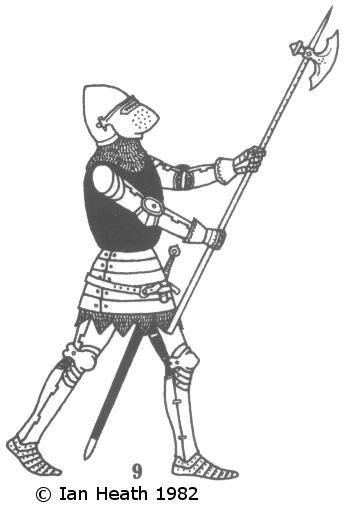
Register a SNAP EBT card with Amazon

DISMOUNTED MAN-AT-ARMS c.1400-20
An extract from Armies of the Middle Ages, Volume 1by Ian Heath


9. DISMOUNTED MAN-AT-ARMS c.1400-20
This figure comes from an edition of the ‘Chroniques de St Denis’ that is normally dated to c. 1420, but from the internal evidence of the armour it portrays is almost certainly about 20 years earlier. He is little different from Sir Thomas except that his breast and back plates are covered in fabric. Such fabric-covered armour was around from early on in the 14th century, when helmets were frequently thus covered by armourers (often, it would seem, in order to conceal that the helmet was either old or of poor workmanship!). Early examples of body-armour being covered in this way are the harness covered in white taffeta with a blue border that Edward III gave to the Earl of Lancaster in 1348, and the armour covered in black velvet embroidered with white ostrich feathers (i.e., his livery) that the Black Prince gave to one of his followers. However, as far as contemporary illustrations are concerned the particular form of fabric covering depicted here, sometimes with sleeves, was fashionable only for a very brief period around 1400. Such illustrations also indicate that the mail aventail, or at least that portion of it resting on the shoulders, could have a cloth cover, with the mail often visible simply as a fringe along its lower edge.
The weapon he carries is a variety of pole-axe that had become popular by about this date. It usually had a 5½-7 foot shaft with a head comprising a combination of axe, hammer and spike, affixed to the shaft by langets up to 3 feet in length. The ‘pole’ of the weapon’s name does not derive from the long shaft but rather from poll, meaning ‘head’; indeed, some early texts actually call it a pollax. The bec de faucon of figure 35 was also termed a pole-axe in England.